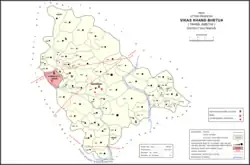Pindoriya | |
|---|---|
Village | |
 Map showing Pindoriya (#477) in Bhetua CD block | |
 Pindoriya Location in Uttar Pradesh, India | |
| Coordinates: 26°10′52″N 81°50′53″E / 26.181228°N 81.848193°E[1] | |
| Country | |
| State | Uttar Pradesh |
| Division | Ayodhya |
| District | Amethi |
| Area | |
| • Total | 6.571 km2 (2.537 sq mi) |
| Population (2011)[2] | |
| • Total | 3,744 |
| • Density | 570/km2 (1,500/sq mi) |
| Languages | |
| • Official | Hindi, Urdu |
| Time zone | UTC+5:30 (IST) |
Pindoriya is a village in Bhetua block of Amethi district, Uttar Pradesh, India.[2] As of 2011, it has a population of 3,744 people, in 649 households.[2] It has one primary school and no healthcare facilities and does not host a weekly haat or permanent market.[2] It belongs to the nyaya panchayat of Bhetua.[3]
The 1951 census recorded Pindoriya (as "Pendoriya") as comprising 15 hamlets, with a total population of 1,535 people (770 male and 765 female), in 346 households and 325 physical houses.[4] The area of the village was given as 1,680 acres.[4] 82 residents were literate, all male.[4] The village was listed as belonging to the pargana of Amethi and the thana of Raipur.[4] The village had a district board-run primary school with 115 students in attendance as of 1 January 1951.[4]
The 1961 census recorded Pindoriya (as "Pendoriy") as comprising 16 hamlets, with a total population of 1,578 people (770 male and 808 female), in 324 households and 298 physical houses.[5] The area of the village was given as 1,680 acres and it had a post office at that point.[5]
The 1981 census recorded Pindoriya as having a population of 2,110 people, in 375 households, and having an area of 659.25 hectares.[6] The main staple foods were listed as wheat and rice.[6]
The 1991 census recorded Pindoriya as having a total population of 2,533 people (1,254 male and 1,279 female), in 415 households and 410 physical houses.[3] The area of the village was listed as 659.00 hectares.[3] Members of the 0-6 age group numbered 429, or 17% of the total; this group was 50% male (216) and 50% female (213).[3] Members of scheduled castes numbered 455, or 18% of the village's total population, while no members of scheduled tribes were recorded.[3] The literacy rate of the village was 46.5% (710 men and 269 women, counting only people age 7 and up).[3] 791 people were classified as main workers (635 men and 156 women), while 25 people were classified as marginal workers (all women); the remaining 1,717 residents were non-workers.[3] The breakdown of main workers by employment category was as follows: 404 cultivators (i.e. people who owned or leased their own land); 226 agricultural labourers (i.e. people who worked someone else's land in return for payment); 1 worker in livestock, forestry, fishing, hunting, plantations, orchards, etc.; 0 in mining and quarrying; 50 household industry workers; 26 workers employed in other manufacturing, processing, service, and repair roles; 2 construction workers; 11 employed in trade and commerce; 1 employed in transport, storage, and communications; and 70 in other services.[3]
References
- ↑ "Geonames Search". Do a radial search using these coordinates here.
- 1 2 3 4 5 "Census of India 2011: Uttar Pradesh District Census Handbook - Sultanpur, Part A (Village and Town Directory)" (PDF). Census 2011 India. pp. 226–42. Retrieved 17 December 2021.
- 1 2 3 4 5 6 7 8 Census 1991 Series-25 Uttar Pradesh Part-XII B Village & Townwise Primary Census Abstract District Census Handbook District Raebareli (PDF). 1992. pp. xxiv–xxviii, 138–9. Retrieved 17 December 2021.
- 1 2 3 4 5 Census of India, 1951: District Census Handbook Uttar Pradesh (49 - Rae Bareli District) (PDF). Allahabad. 1955. pp. 102–3, 198. Retrieved 17 December 2021.
{{cite book}}: CS1 maint: location missing publisher (link) - 1 2 Census 1961: District Census Handbook, Uttar Pradesh (44 - Sultanpur District) (PDF). Lucknow. 1965. pp. l–li. Retrieved 17 December 2021.
{{cite book}}: CS1 maint: location missing publisher (link) - 1 2 Census 1981 Uttar Pradesh: District Census Handbook Part XIII-A: Village & Town Directory, District Rae Bareli (PDF). 1982. pp. 104–5. Retrieved 17 December 2021.